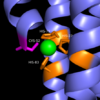Sandbox Reserved 1070
From Proteopedia
| This Sandbox is Reserved from 02/09/2015, through 05/31/2016 for use in the course "CH462: Biochemistry 2" taught by Geoffrey C. Hoops at the Butler University. This reservation includes Sandbox Reserved 1051 through Sandbox Reserved 1080. |
To get started:
More help: Help:Editing |
Contents |
DgcZ from E. coli
|
This is a default text for your page '. Click above on edit this page' to modify. Be careful with the < and > signs. You may include any references to papers as in: the use of JSmol in Proteopedia [1] or to the article describing Jmol [2] to the rescue.
Biological Function
Structural Overview
Mechanism of Action
Zinc Ligand(s)
Most cells possess efficient Zinc uptake systems, as Zinc is a reactive Lewis Acid. Zinc binds incredibly tightly to this enzyme at subfemtomolar concentrations. The Zinc co-purified with the protein.
Zinc Binding Site
Zinc allosterically inhibits the activity of the enzyme, through an allosteric binding site located on the CZB domain of DgcZ. The CZB domain, where the Zinc binding sites are located, regulates the function of the GGDEF domain, containing the active site. CZB is the N-terminal domain, and is folded into four anti-parallel α-helices, as a 2-fold symmetric homodimer. Zinc coordinates to three amino acids spanning three of the four alpha helices in the CZB domain: the H22 residue of 𝝰1, C52 𝝰2, and H79 and H83 of 𝝰3,and 𝝰4 helix containing the N-terminus. Zinc can be removed from the CZB domain using EDTA. The zinc has higher affinity for EDTA than CZB when EDTA concentration is higher than the concentration of DgcZ. When Zinc is removed, the 𝝰1 helix straightens burying nonpolar side-chain residues, subsequently increasing the activity of DgcZ. Activity increases without Zinc, with activation of poly-GlcNAc production and biofilm formation, and maximal cyclic di-GMP production.
Other Ligands
Binding Site
This is a sample scene created with SAT to by Group, and another to make of the protein. You can make your own scenes on SAT starting from scratch or loading and editing one of these sample scenes.
</StructureSection>
References
- ↑ Hanson, R. M., Prilusky, J., Renjian, Z., Nakane, T. and Sussman, J. L. (2013), JSmol and the Next-Generation Web-Based Representation of 3D Molecular Structure as Applied to Proteopedia. Isr. J. Chem., 53:207-216. doi:http://dx.doi.org/10.1002/ijch.201300024
- ↑ Herraez A. Biomolecules in the computer: Jmol to the rescue. Biochem Mol Biol Educ. 2006 Jul;34(4):255-61. doi: 10.1002/bmb.2006.494034042644. PMID:21638687 doi:10.1002/bmb.2006.494034042644

